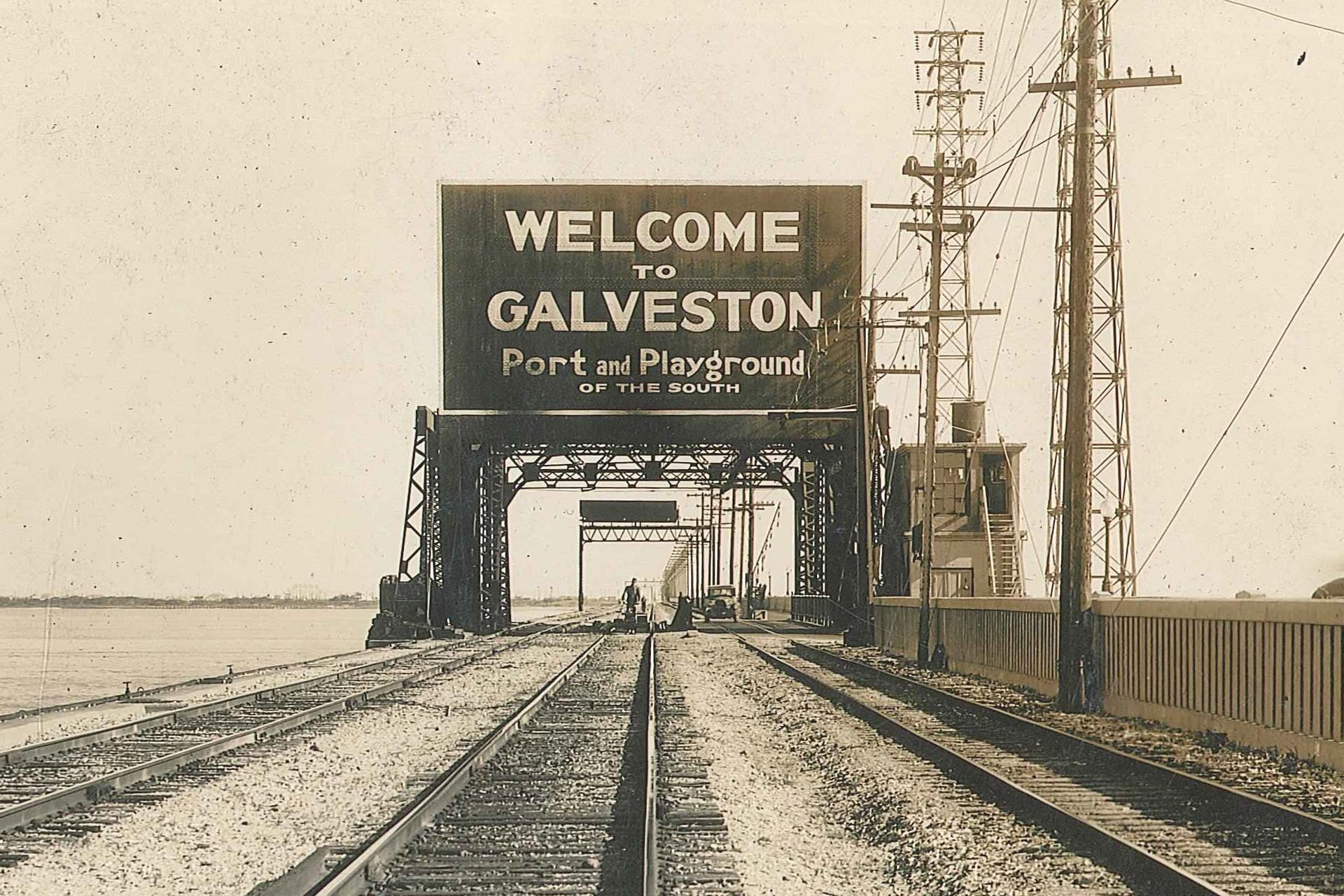Galveston Historical Foundation (GHF) was formed as the Galveston Historical Society in 1871 and merged with a new organization formed in 1954 as a non-profit entity devoted to historic preservation and history in Galveston County. Over the last sixty years, GHF has expanded its mission to encompass community redevelopment, historic preservation advocacy, maritime preservation, coastal resiliency and stewardship of historic properties. GHF embraces a broader vision of history and architecture that encompasses advancements in environmental and natural sciences and their intersection with historic buildings and coastal life and conceives of history as an engaging story of individual lives and experiences on Galveston Island from the 19th century to the present day.
FINANCIAL INFORMATION
Current financial documents about Galveston Historical Foundation are available below.
ORGANIZATIONAL TIMELINE
Learn more about Galveston Historical Foundation through our timeline of key events.
1871
Galveston Historical Society is founded, primarily as a historical and literary society.
1954
Galveston Historical Foundation (GHF) is created by early volunteer leaders, in an effort to save the 1839 Samuel May Williams house from demolition.
1958
In a meeting at Rosenberg Library, at the direction of Katherine Randall, Galveston Historical Society merges with Galveston Historical Foundation.
1966
The west portion of Hendley Row (2002-2016 Strand), the oldest commercial building on The Strand, is saved from demolition by early preservationists, Jack and Sally Wallace, and donated to GHF.
1967
In partnership with the National Parks Service, GHF assists with the Historic American Buildings Survey (HABS), documenting and photographing more than 500 structures within the island’s east end and along The Strand.
1969
The Strand is listed on the National Register of Historic Places.
1971
GHF and community leaders save Ashton Villa from demolition. With title held by the City of Galveston, GHF raises funds for purchase and restoration
City Council designates the East End Historic District a locally zoned historic district.
1973
The Strand Revolving Fund is established to purchase key Strand buildings to resell for restoration and redevelopment. Key financial support is received from the Moody Foundation and the Kempner Fund.
Preservation lawyer Peter Brink is hired to oversee the fund as serve as executive director of GHF.
1974
Ashton Villa opens as a house museum, managed and operated by GHF.
GHF sponsors the first annual Dickens Evening on The Strand to call attention to The Strand’s value and potential.
GHF locates the 1877 Tall Ship ELISSA in a Greek scrap yard. The Foundation raises money to purchase the vessel, returning her to Galveston where restoration begins.
1975
GHF hosts the first annual Historic Homes Tour.
1976
The Silk Stocking District is designated a locally zoned historic district.
1978
GHF closes the 1839 Williams House and begins complete restoration of the property.
1979
GHF completes restoration of the western section of Hendley Row for organization headquarters, and opens The Strand Visitors Center on the first floor. A wall on the west side of the building, designed by Taft Architects, shores up the exposed western elevation of the building and conceals modern plumbing and a fire stair.
1980
GHF begins the Paint Partnership Program, benefitting Galveston’s low-to-moderate income families. The Foundation also begins providing design and rehabilitation advice to homeowners of historic properties.
Taft Architects received the Texas Society of Architects Honor Award for restoration work on the western section of Hendley Row.
1981
Dickens on The Strand is expanded to two days.
GHF Residential Program begins providing demonstration classes and workshops on rehabilitation techniques.
Taft Architects is awarded both the American Institute of Architects (AIA) Honor Award and the Houston AIA Honor Award for Hendley Wall. Taking advantage of a structural requirement to distinguish between old and new, the structural frame wall required to buttress the end wall of Hendley Row houses a fire stair, bathrooms and mechanical cores for the Foundation’s administrative offices and visitors center.
1982
The Residential Revolving Fund is established.
The 1877 Tall Ship ELISSA is christened and opened to the public for tours, with a lease from the Galveston Wharves to berth at Pier 21.
1984
The 1839 Samuel May Williams house is reopened to the public for tours.
Galveston County awards GHF contract to manage and operate the Galveston County Historical Museum.
1985
Downtown Revitalization Committee is established, with GHF support.
1986
GHF and Galveston Arts successfully complete a $4,000,000 capital campaign. As a result, the 1894 Grand Opera House re-opens to the public, fully restored.
GHF purchases the 1886 Darragh House with the Residential Revolving Fund, holding the first of the Darragh House Dinners soon after.
Celebrating the centennial of the Statue of Liberty, ELISSA sails to New York, representing Galveston and Texas in the Parade of Tall Ships.
1987
ELISSA sails to Beaumont and Biloxi, Mississippi.
1988
At GHF’s urging, the City of Galveston establishes a locally zoned Strand/Mechanic Historic District, creating design guidelines for the downtown district.
GHF announces construction plans for a new Texas Seaport Museum.
Paint Partnership Program expands to include a volunteer paint crew called “Paint Pals” to paint homes owned by elderly or handicapped individuals.
Low interest rehabilitation loans for East End and Silk Stocking District properties are established by GHF.
1989
GHF begins construction of the Texas Seaport Museum in October. ELISSA is certified by U.S. Coast Guard for continued sailing. Soon after, she completes her most ambitious trip to date, a 10-port, 3000 mile TEXAS PROUD VOYAGE.
“Historic Paint Colors” for Galveston’s residential structures is completed by GHF for use by homeowners.
The 1886 Darragh House porch and columns are restored, and the house is featured on the Foundation’s Historic Homes Tour.
GHF hosts first conference on Galveston’s neighborhoods.
GHF’s first Executive Director, Peter Brink, announces his resignation to assume responsibilities of a vice president for the National Trust for Historic Preservation. GHF President Barbara Pickelman forms a search committee to seek Brink’s replacement.
ELISSA visits Houston as part of the Port of Houston’s 75th anniversary.
1990
GHF signs 50-year lease agreement with Houston/ Galveston Catholic Diocese for the 1859 St. Joseph’s Church.
Betty Massey is named GHF executive director. Massey, who served as the Foundation’s interim director, had worked for GHF for the past seven years, serving as director of museums, organization review coordinator, director of the Galveston County Historical Museum and education director.
Galveston is selected as one of four regions in Texas to participate in the Heritage Tourism Initiative pilot program of the National Trust for Historic Preservation.
The 1877 Tall Ship ELISSA is designated a National Historic Landmark.
GHF buys and sells its first central business district structure, the 1858 Pix Building on Postoffice Street.
The Resolution Trust Corporation donates to GHF four properties on Sealy Avenue known as Rainbow Row. This is the first time in the nation that the RTC has given property to a non-profit organization. The Foundation commits to rehabilitating the properties, selling them to low-to-moderate income families.
The 1886 Darragh House, held by GHF’s Residential Revolving Fund is sold. New owners begin preservation of the East End landmark. Arson strikers three times, eventually destroying the structure. GHF votes to repurchase the property and demolish the structure.
1991
Texas Seaport Museum opens to the public with a gala celebration benefitting GHF.
Restoration work is completed on Rainbow Row.
GHF purchases an enclave of late 19th and early 20th century cottages at the corner of 14th and Church Streets, creating the beginnings of a target block along Church Street, between 14th and 15th Streets.
Texas Governor Ann Richards presents GHF with the first Governor’s Award for Historic Preservation.
With a grant from the Moody Foundation and a lease with the American National Insurance Company, GHF opens the American National Observation Area to the public.
1992
The Preservation Texas Alliance presents GHF with the Driscoll Award for the Best Preservation Success for Rainbow Row and the Cotton Award for Best Newsletter for a non-profit organization.
Rainbow Row houses are sold to first-time homeowners who receive special training in homeownership through cooperative programs with Galveston College.
GHF purchases the 1838 Michel Menard house, saving it from demolition.
1993
GHF undertakes organizational analysis and reorganizes staffing structure.
GHF receives Mary Moody Northen Award from the Texas Historical Commission for rehabilitation of Rainbow Row.
GHF signs management agreement with Mitchell Historic Properties, opening the Pier 21 Theater.
The Menard house is the featured “restoration in progress” on GHF’s annual Historic Homes Tour. GHF sells the house soon after to new owners who embark on a complete rehabilitation of the property.
1995
GHF signs management agreement with the owners of the Michel Menard house opening it to the public for tours and private events.
1996
To celebrate their 125th anniversary, GHF partners with Rice University and architectural historians Stephen Fox and Ellen Beasley to publish the Galveston Architectural Guidebook, a comprehensive city-wide guidebook highlighting the island’s rich architectural inventory. The Harris and Eliza Kempner Fund provide support for the project with funds from its Program-Related Investment Program.
1997
With funds donated by Dr. Burke Evans, Galveston Historical Foundation acquires the 1909 Sealy Garage. The garage was part of a major remodeling project that included its construction and a complete interior and exterior overhaul of the Sealy Mansion across Avenue I (Sealy Avenue).
1998
Kempner Park and the 1880 Garten Verein Pavilion are refurbished to commemorate the 50th anniversary of the Harris and Eliza Kempner Fund. GHF assumes management of the Pavilion with the City continuing to maintain the grounds of the park.
1999
GHF signs long-term lease with General Services Administration and begins $1,500,000 restoration of the 1861 Custom House.
GHF creates the Preservation Resource Center (PRC), offering assistance with research on the history of buildings, proper methods of rehabilitation and sources for materials.
2000
GHF relocates their headquarters from Hendley Row to Custom House, closing the Strand Visitors Center and opening the Heritage Visitors Center in the carriage house at the 1859 Ashton Villa.
GHF completes rehabilitation of the Sealy Garage.
GHF executive director, Betty Massey announces her resignation. On September 1st, she assumes the position of executive director of the Mary Moody Northen Endowment.
2001
GHF relocates its Architectural Salvage Warehouse from its warehouse on Mechanic Street to the Sealy Garage.
2002
After a nationwide search, Marsh Davis, director of community services for the Historic Landmarks Foundation of Indiana, is named executive director of GHF.
GHF purchases wooden shrimp boat Santa Maria from Joe and Edna Grillo. The vessel has been part of Galveston’s Mosquito Fleet since being launched in 1937.
GHF announces plans to stabilize a 1910 smokestack on Harborside Drive and 21st. The 120 foot smokestack once served as an exhaust pipe for the Galveston Ice and Cold Storage Company. The project is awarded to the Gerard Chimney Company of St. Louis.
GHF purchases the 50-foot catamaran SEAGULL II and announces plans to conduct historic harbor tours, dolphin watch tours and educational programming aboard the vessel.
2003
Galveston is named among America’s Dozen Distinctive Destinations, a list of “unique and lovingly preserved communities” issued each year by the National Trust for Historic Preservation. While making the award, the Trust cited the fact that Galveston has over 550 structures listed in the National Register of Historic Places.
Modeled after the National Trust for Historic Preservation’s annual 11 Most Endangered Historic Places, GHF initiates the “Heritage at Risk” List, drawing attention to historic buildings and resources in danger of being lost around Galveston Island.
2004
Ashton Villa is featured on Home and Gardens Television (HGTV) series “Restore America”.
GHF rescues and relocates two 106 year old Queen Anne houses in the 1700 block of Avenue O1/2 threatened by encroaching commercial development. The houses are relocated to the 1300 and 1200 blocks of Avenue M.
2005
GHF replaces the roof on the 1861 Custom House after Hurricane Rita.
GHF announces that gate admissions from Dickens on The Strand was among the highest in ten years, netting over $200,000 in two days.
Badly in need of repairs due to years of deferred maintenance, GHF announces cooperative efforts between the Foundation, the city of Galveston and the Houston Galveston Catholic Diocese to save the 1892 Bishop’s Palace.
2006
GHF executive director Marsh Davis announces his resignation in July.
GHF names Dwayne Jones, executive director of Preservation Dallas, as executive director of GHF. After a nationwide search, Jones, was selected from a field of 60 applicants.
2007
GHF signs management agreement with Houston/Galveston Catholic Diocese for the 1892 Walter and Josephine Gresham house, popularly known as the Bishop’s Palace.
GHF is awarded a Save America’s Treasures grant from the National Park Service for Ashton Villa, designated a nationally significant property.
Plagued by declining attendance, GHF closes the 1839 Samuel May Williams house. The property is transformed into the 2007 American Society of Interior Designers (ASID) Designer Showhouse and featured on the Foundation’s annual Historic Homes Tour, after which the house is leased by GHF to a long-term tenant as part of a resident-curator program.
Developers Judy and John Saracco donate Galveston’s oldest African American cemetery, Rosewood, to GHF. The cemetery was established in 1911 by a group of African American citizens who organized themselves as the Rosewood Cemetery Association. Cemetery records indicate 411 graves are within Rosewood although markers exist for only around 20.
2008
Hurricane Ike makes landfall on September 13th, causing significant damage in the community, including all of the Foundation’s historic properties.
Hosted on December 6th and 7th, GHF’s annual Dickens on The Strand is the first community event after Ike.
GHF receives $100,000 grant from the 1772 Foundation to buy small historic houses damaged by Hurricane Ike.
2009
With assistance from the Federal Emergency Management Agency, GHF begins extensive rehabilitation of all its historic properties damaged by Hurricane Ike.
“Save America’s Treasures,” a collaborative program led by the President’s Committee on the Arts and Humanities and administered by the National Park Service, awards GHF a $371,000 matching grant in support of the Foundation’s efforts to preserve the Bishop’s Palace roof.
GHF purchases the 1861 Custom House from the General Services Administration.
2010
Using grant from the 1772 Foundation, GHF revives an 1891 cottage into a Green Revival Showhouse, demonstrating how the energy efficient properties inherent in historic design and original fabric can work in tandem with sensitively planned modern systems to conserve resources as well as heritage. GHF’s Green Revival House, the 1891 Christian Wolfer Tenant Cottage, is featured on the Foundation’s annual Historic Homes Tour.
2011
GHF purchases the 1890 McKinney McDonald house, 926 Winnie, in order to save it from demolition. Repairs to the roof, exterior and foundation begin soon after.
GHF’s Green Revival House is designated a local historic landmark. Featuring new insulation, four solar panels, and two rainwater cisterns the cottage is one of the nation’s first historic buildings to achieve Platinum certification through the LEED for Homes program.
2012
Situated on a key intersection leading to the historic downtown district, GHF purchases the 1940 Sears and Roebuck Building, formerly occupied by the Salvation Army and announces plans to rehabilitate the property.
GHF completes a $1.2 million dollar capital campaign for ELISSA’s hull restoration.
2013
GHF purchases the 1892 Bishop’s Palace after a $3,000,000 capital campaign.
GHF’s Preservation Services department relocates to the Sears Building, along with the Foundation’s Architectural Salvage Warehouse, Historic Properties rentals and maintenance staff and museum collections and retail operations.
GHF renews presence on The Strand with the opening of its new retail shop, Eighteen Seventy One. The name harkens back to the Foundation’s beginning in 1871.
The Wallace family, long time GHF supporters, donate parking lot at 21st and Strand, on the western end of Hendley Row, to GHF for development as a community park.
2016
GHF accepts Star State Company No. 3 Firehouse at 2828 Market.
GHF staff moves out of the 1861 Custom House, after its sale, to the Sears Building.
2017
GHF purchases the 1904 GH&H train depot.
2018
GHF debuts the Tall Ships Galveston event which welcomes five visiting vessels to Galveston’s historic seaport.
As part of the Tall Ships Challenge, the 1877 Tall Ship ELISSA sails with the fleet to Pensacola, Florida and New Orleans, Louisiana.













